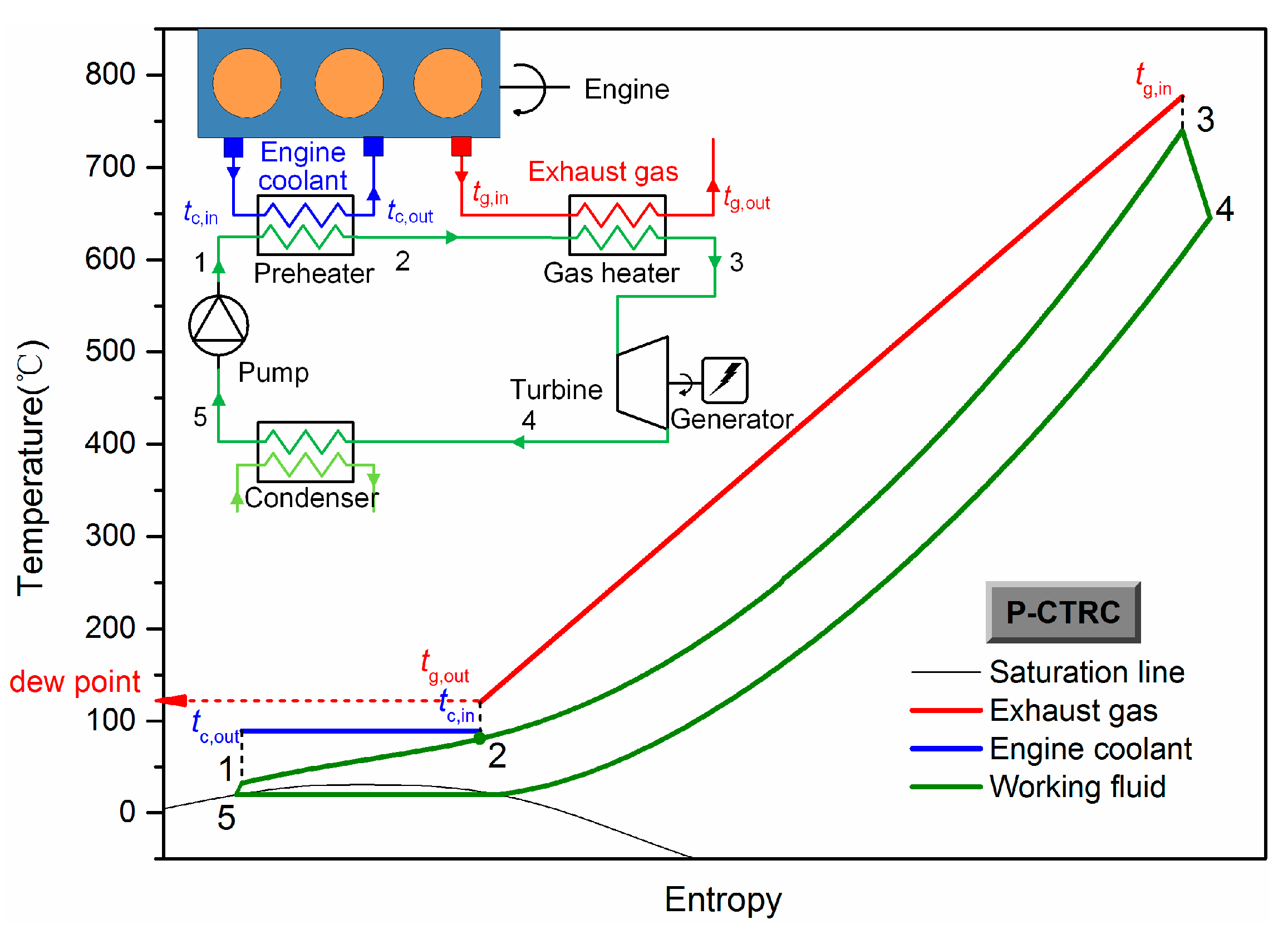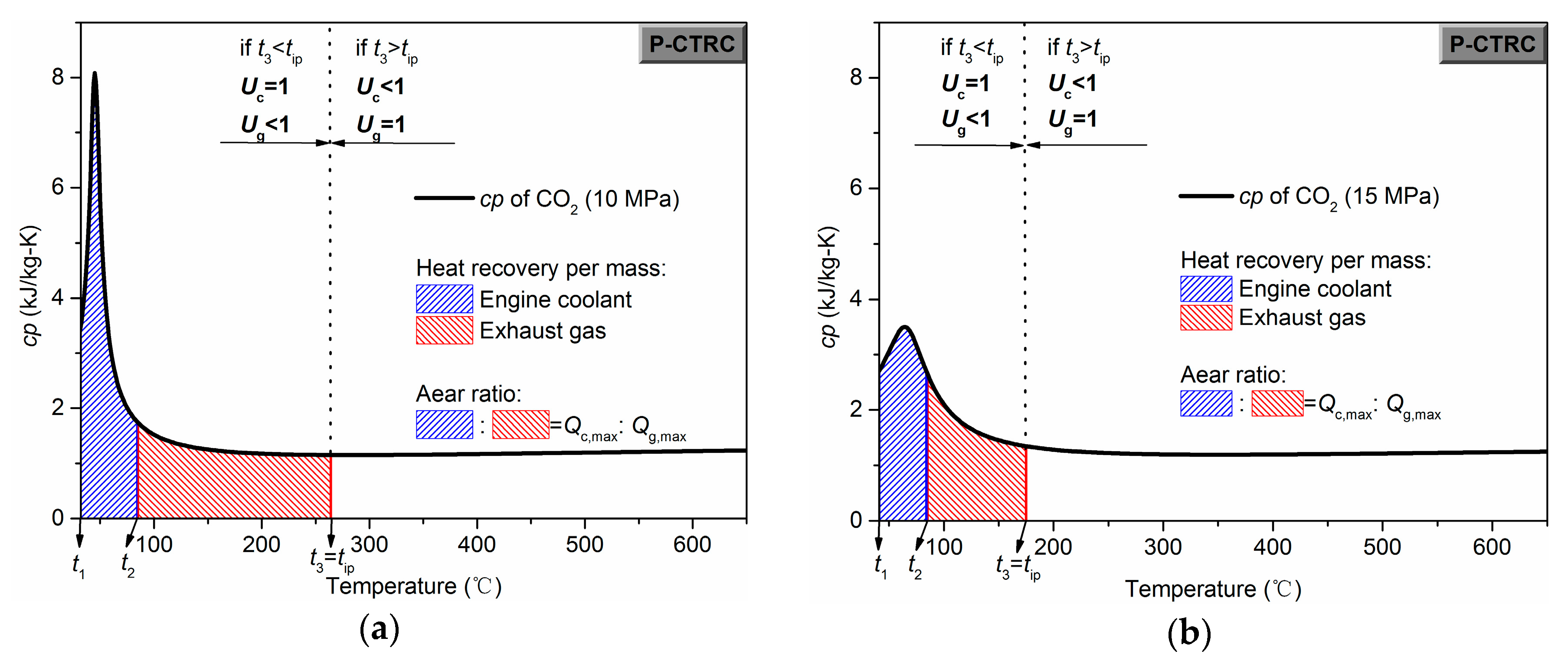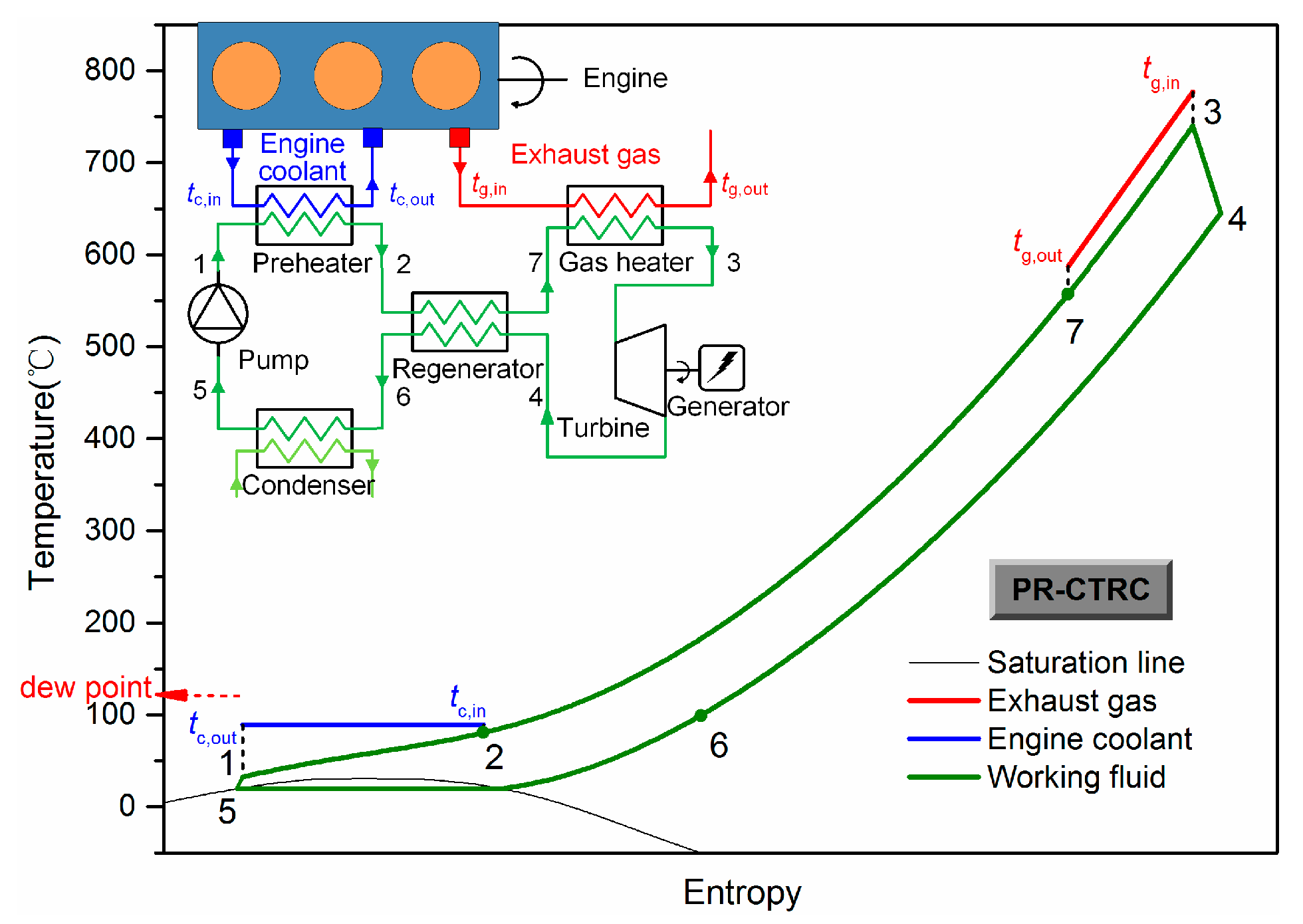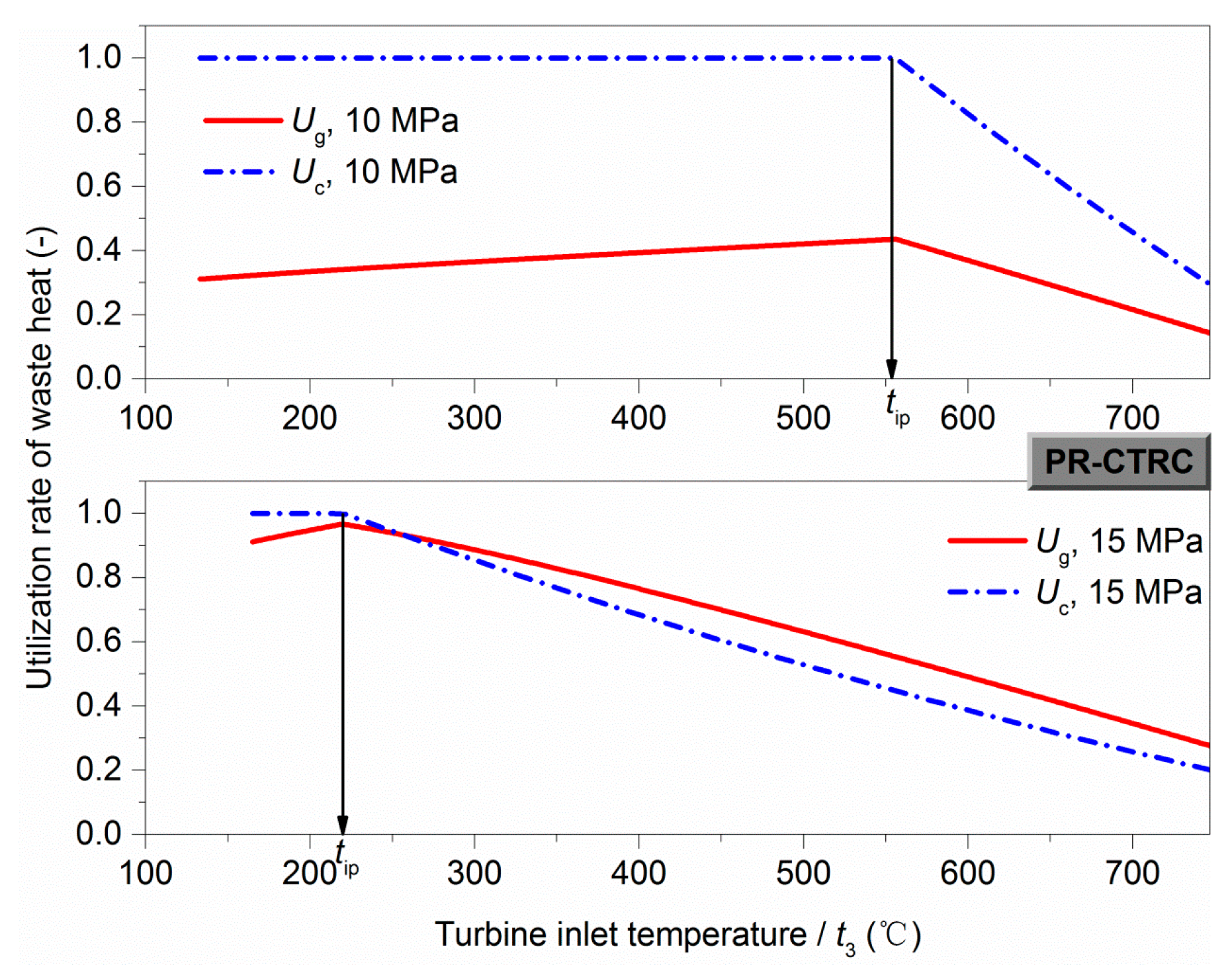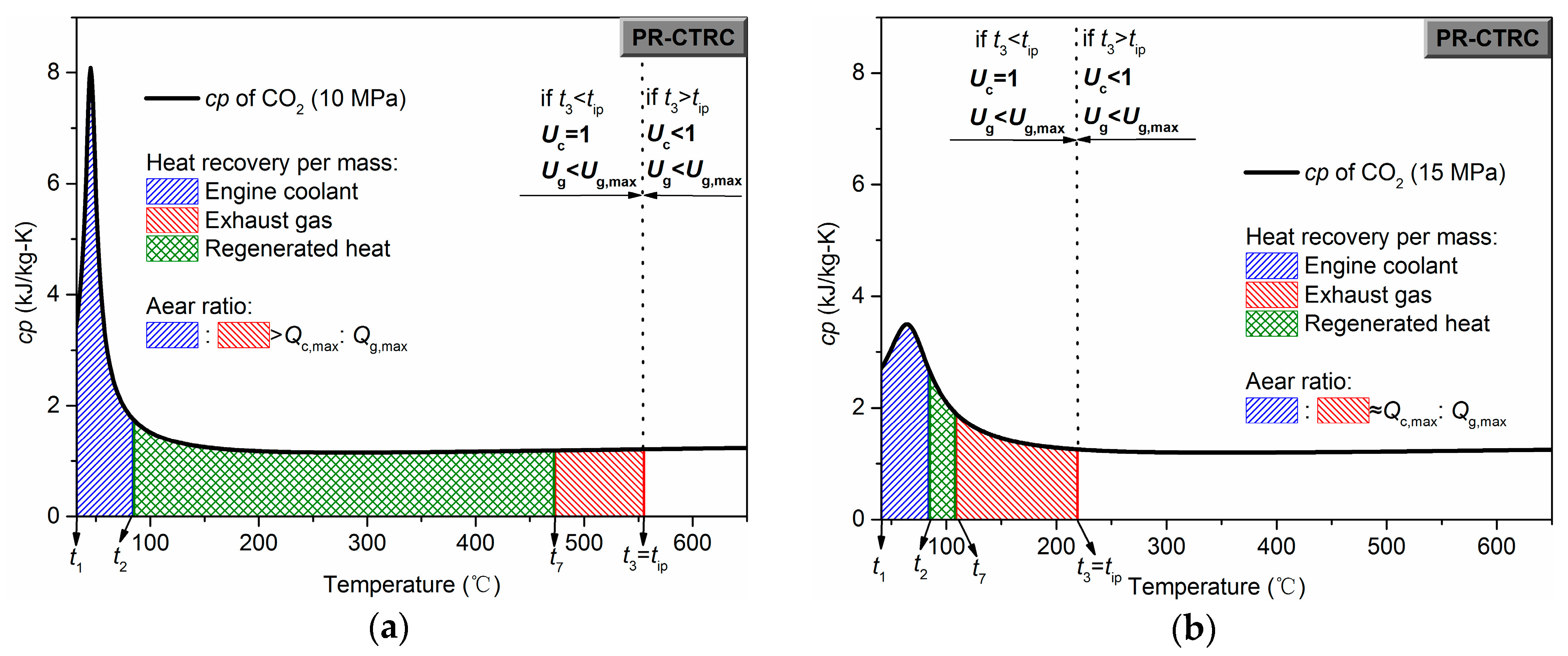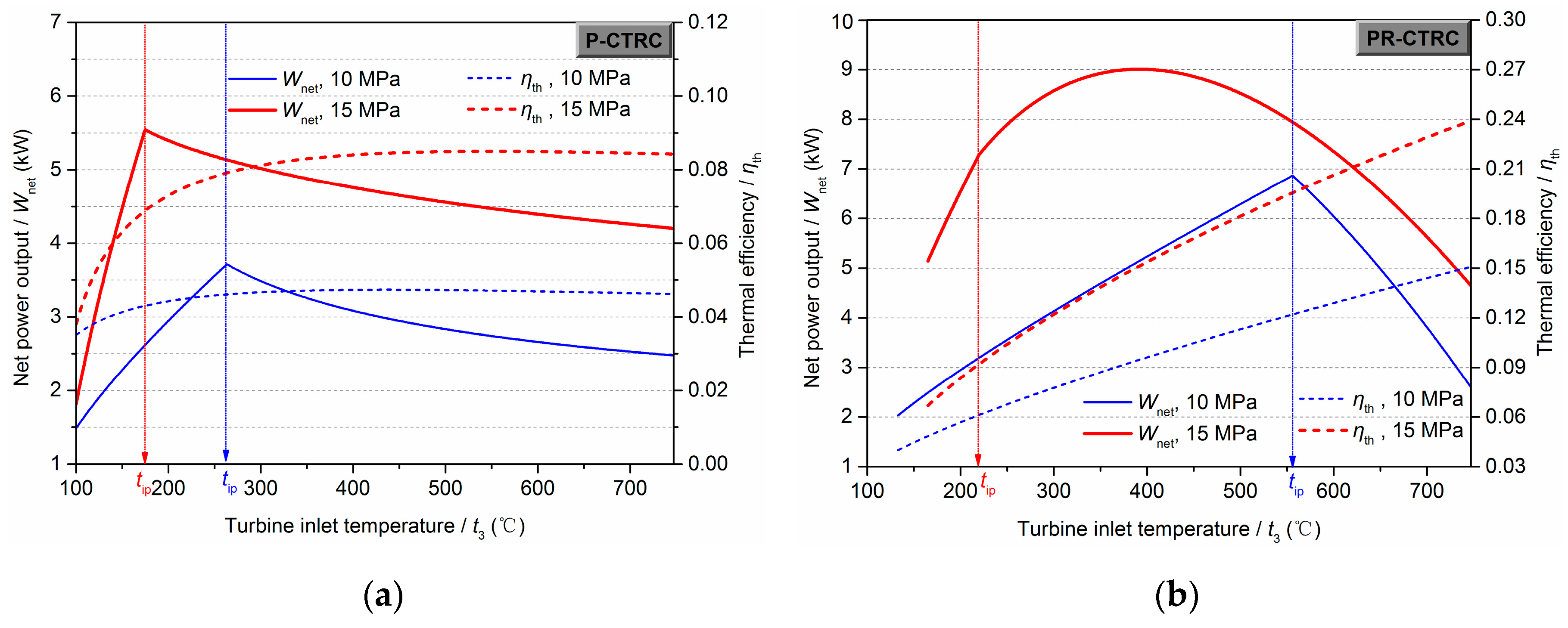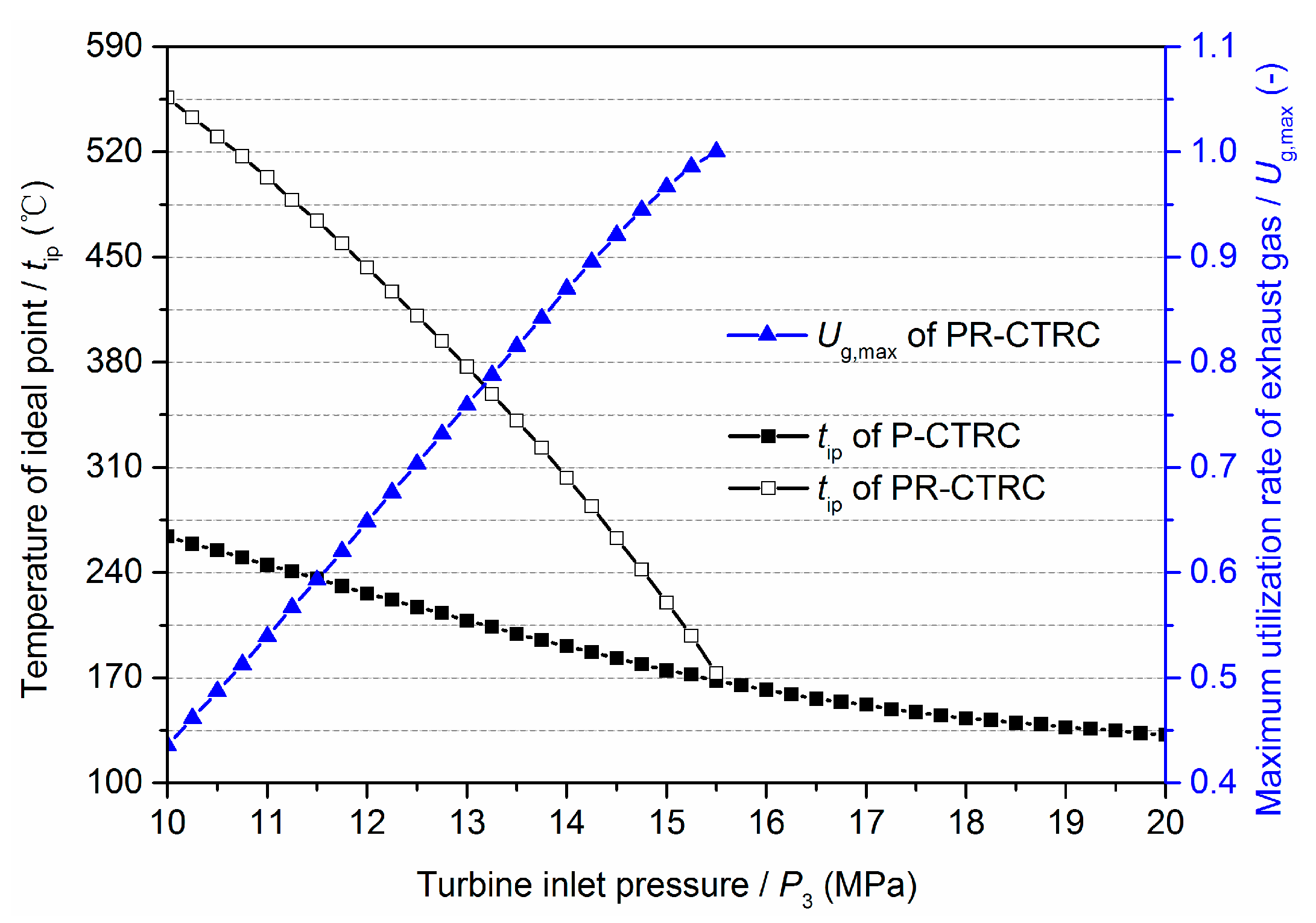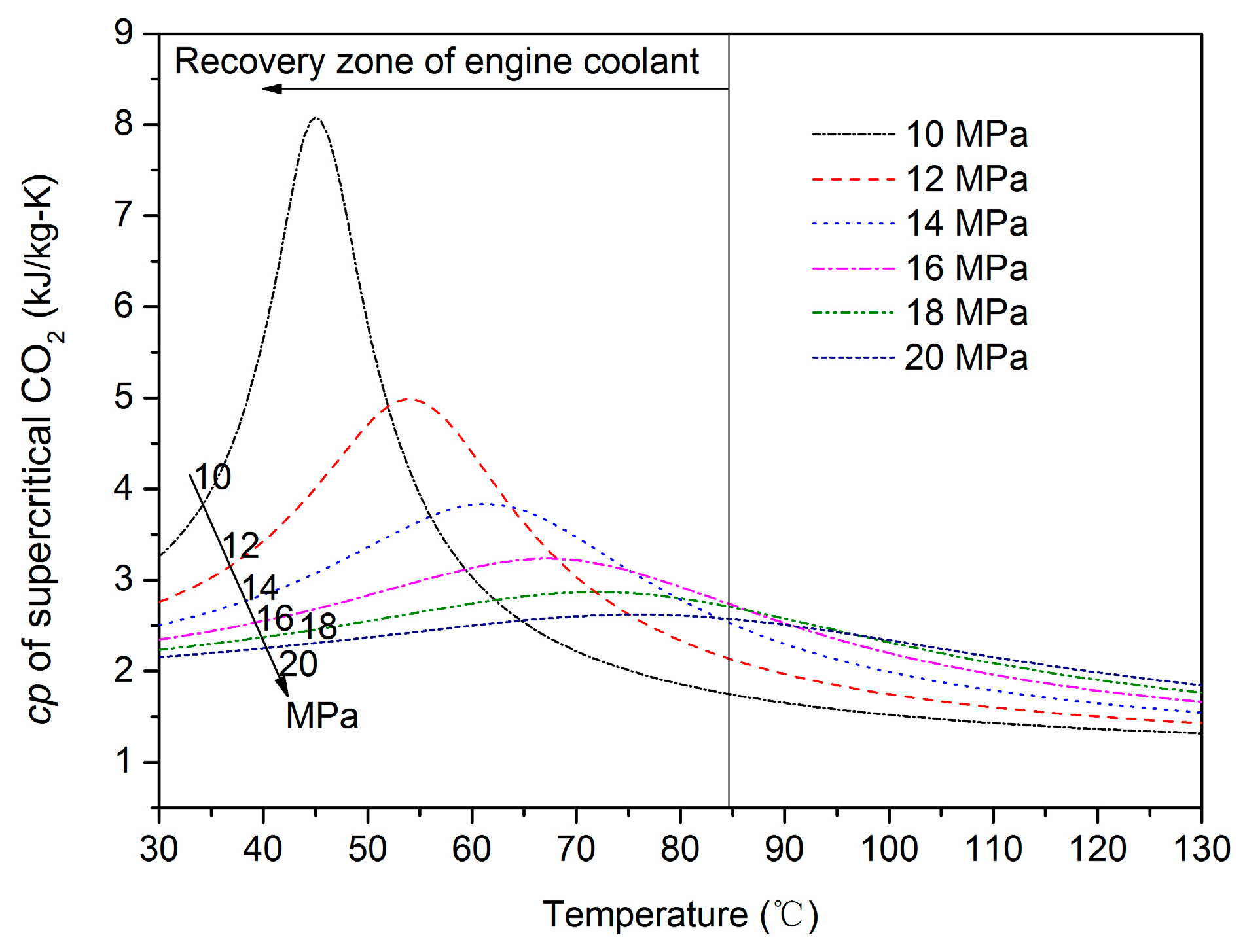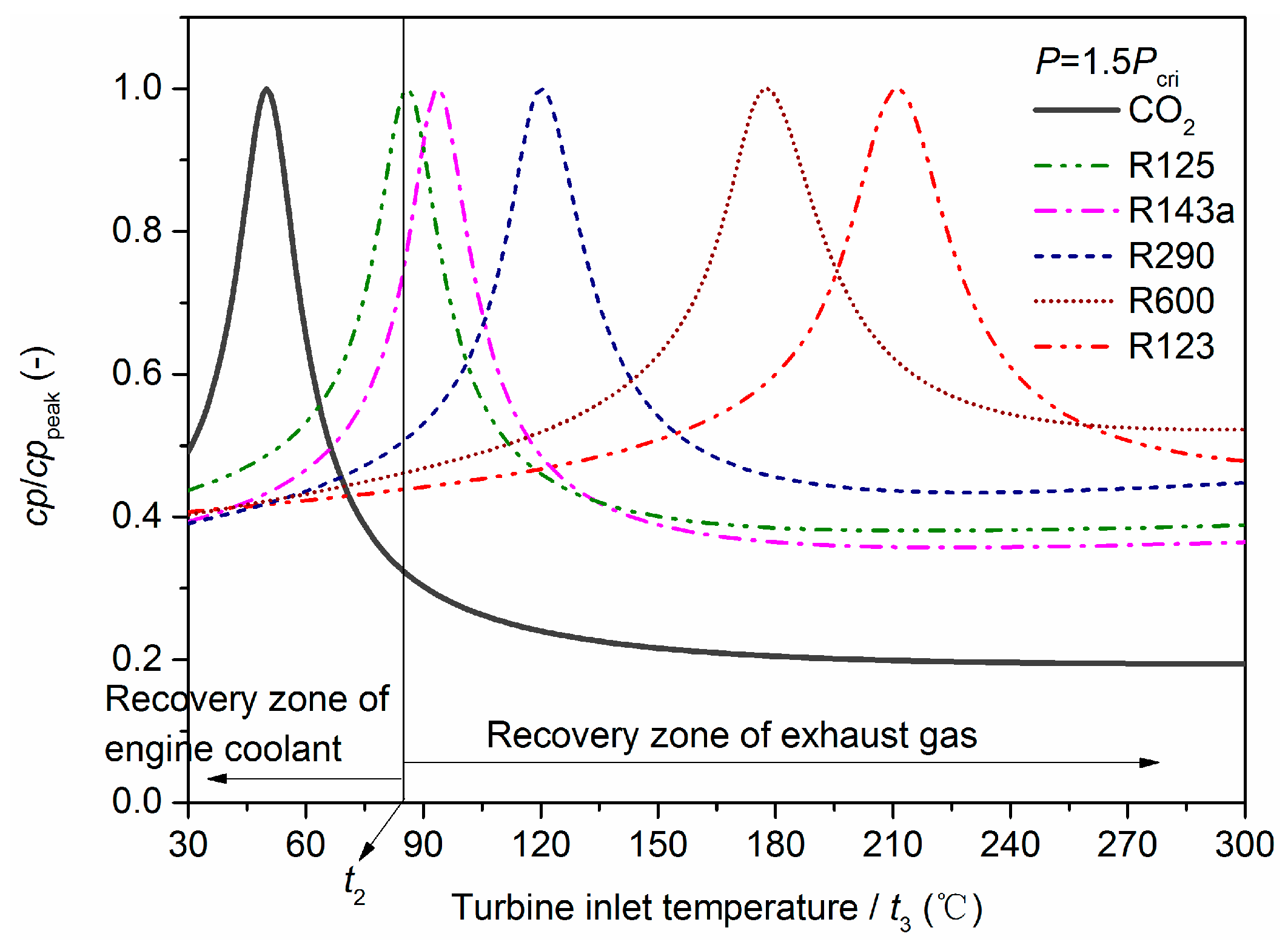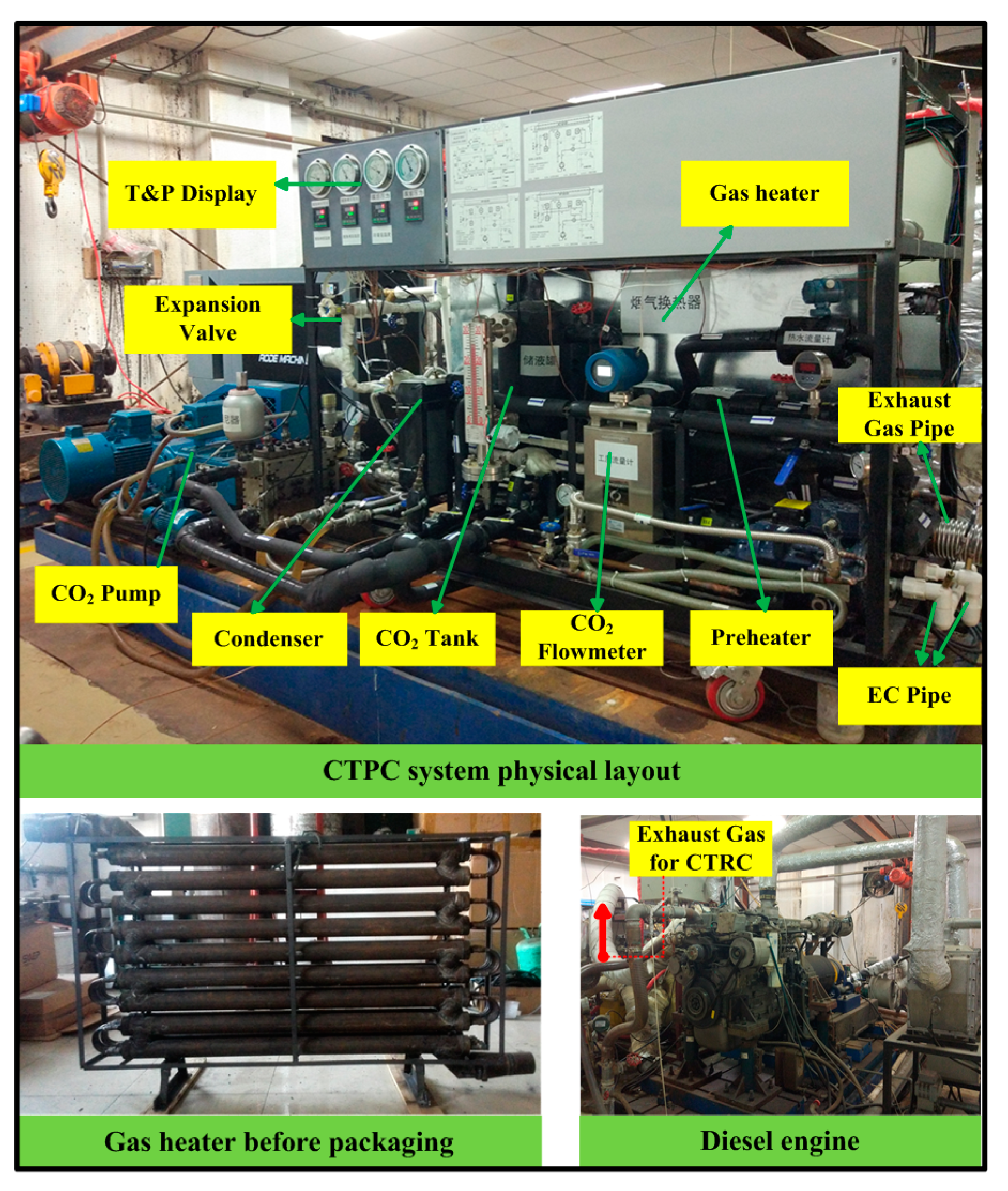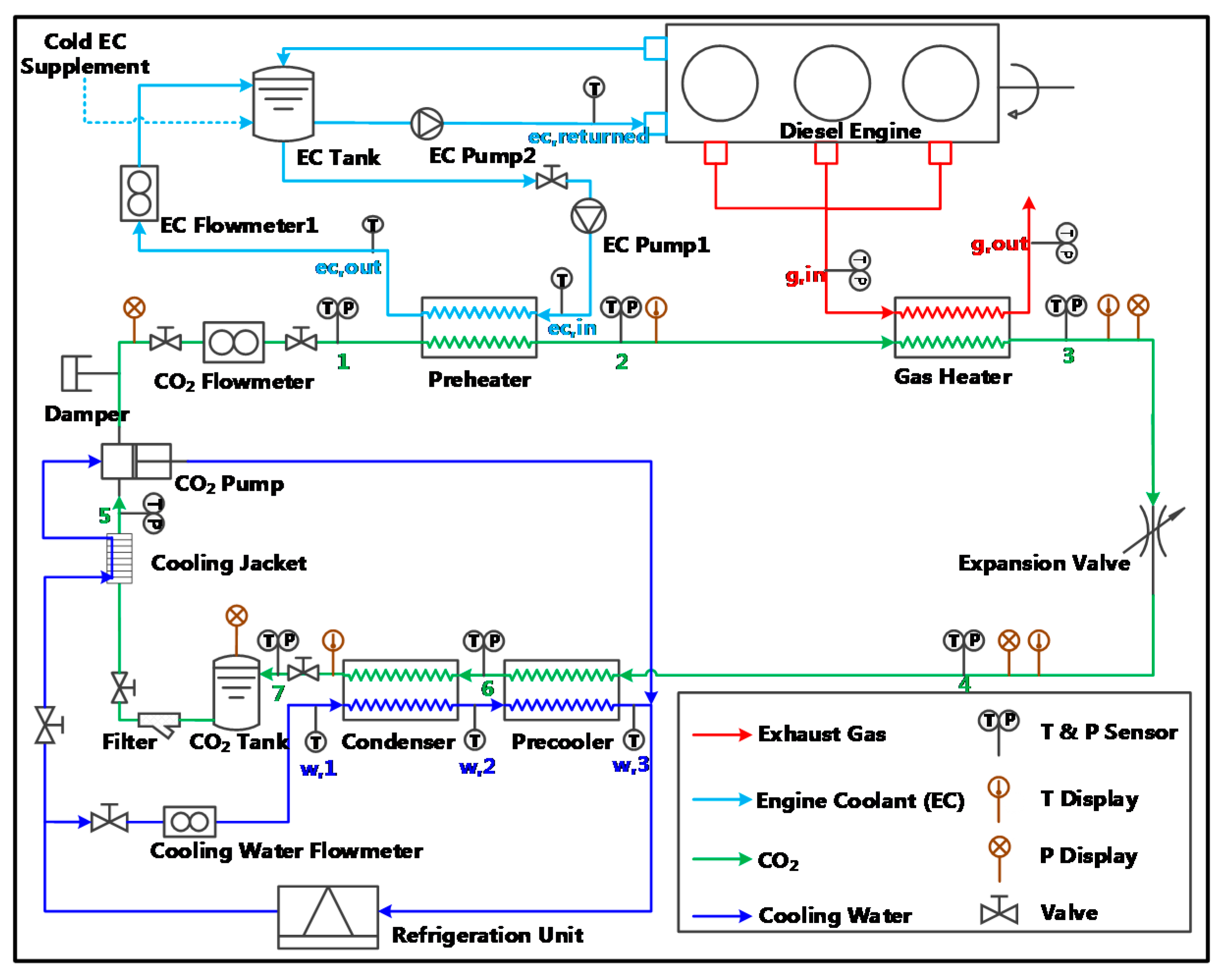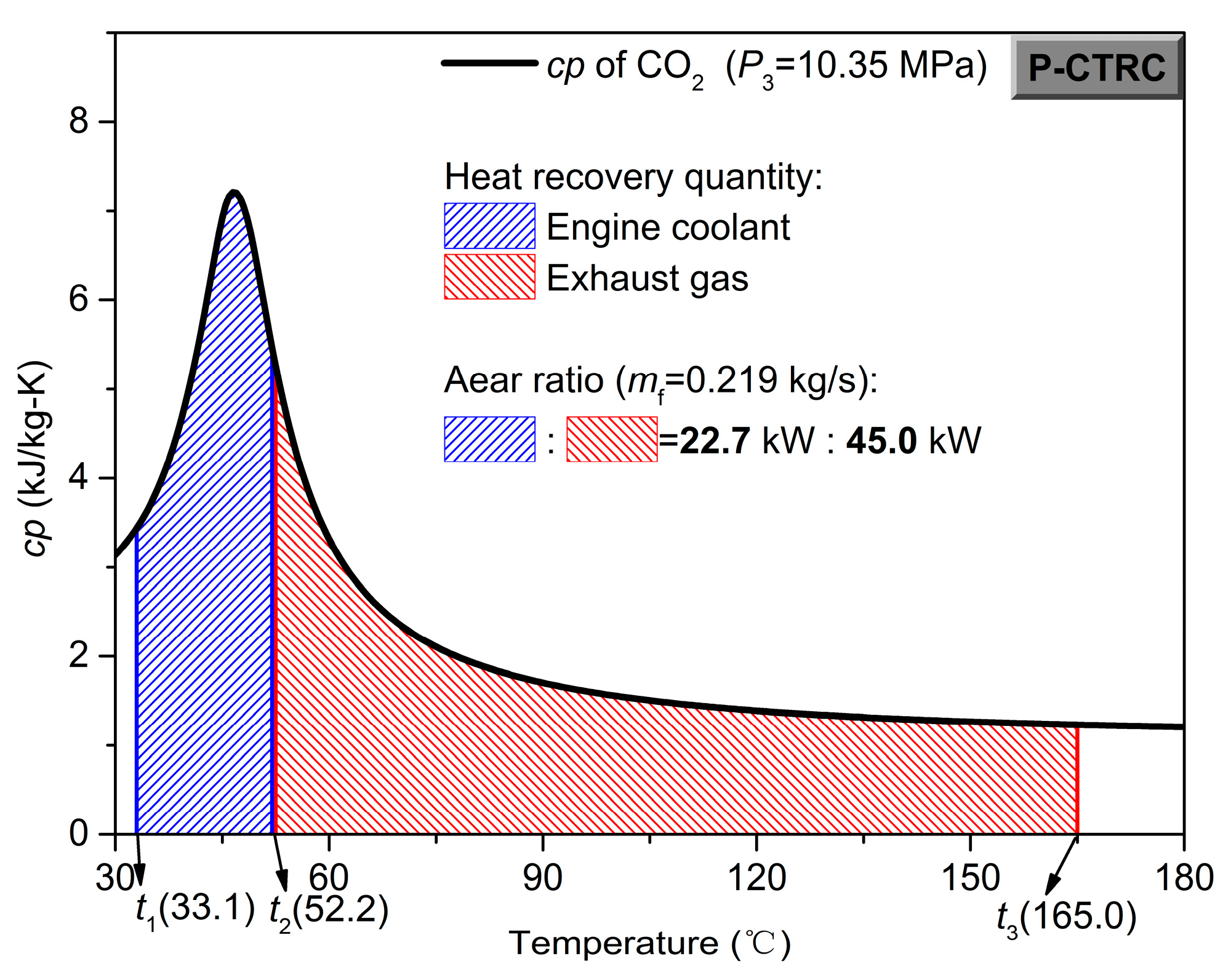3.1. “Ideal Point” Analysis of CTRC
Figure 3 shows the variations of utilization rate of waste heats in the P-CTRC at
P3 = 10 MPa and
P3 = 15 MPa, red lines for the exhaust gas (
Ug) and blue lines for the engine coolant (
Uc).
Ug increases then becomes 1 with an increase in
t3, and
Uc is 1 at low
t3 then reduces with an increase in
t3. It is because higher
t3 needs more waste heat of exhaust gas, and more waste heat of engine coolant is utilized at the condition of lower
t3.
A desired result appears in
Figure 3 that, the change point of
Uc from “1” to “not 1”, and the change point of
Ug from “not 1” to “1”, occurs at the same
t3. It means both complete recovery of exhaust gas and engine coolant will achieve when turbine inlet temperature operates at this
t3. This research called it as “ideal point”, represented as
tip, which means the ideal condition where both complete utilization of exhaust gas and engine coolant are obtained. The
tip changes with the variation of turbine inlet pressure. The
tip is 264 °C at
P3 = 10 MPa, and 175 °C at
P3 = 15 MPa.
For introducing the producing mechanism of ‘ideal point’, the discussion about the CO
2 combined capability between exhaust gas and engine coolant is required from the perspective of the CO
2 property. As shown in
Figure 4a,b, the bold black line means the
cp change of CO
2 with the CO
2 temperature at pressure of 10 MPa and 15 MPa, respectively. The
cp curves have a peak when the CO
2 fluid is at supercritical pressure. The corresponding temperature is called the pseudo-critical temperature. The peak value of
cp and corresponding pseudo-critical temperature changes with pressure. The
cp peak value of 10 MPa is larger than that of 15 MPa, and the pseudo-critical temperature is lower. The enclosed area between the
cp curve and
X axis represents the
cp integration value with temperature, so its size represents the amount of heat absorption. In
Figure 4a,b,
t1 and
t2 (84.4 °C) respectively represent the inlet and outlet temperature of CO
2 in the preheater So the blue area corresponds to heat recovery per mass from the engine coolant. And the temperature range at the right side of
t2 is for the exhaust gas, the red area means the heat recovery per mass from the exhaust gas at the condition of
t3 =
tip. When the turbine inlet temperature is at the ‘ideal point’, the ratio between the blue and red area is just equal to the ratio between the maximum available energy of engine coolant and exhaust gas, which is called the ‘complete recovery ratio’. This means both complete recovery of exhaust gas and engine coolant can be achieved when meeting a suitable mass flow rate. If
t3 is lower than
tip, the engine coolant can get a complete use but the exhaust gas cannot, the blue area is bigger than the red area in this situation. The contrast performance occurs if
t3 >
tip. Therefore, it results in the special
Ug and
Uc performance of “ideal point”. When comparing the performance of 10 MPa and 15 MPa, it can be found that the smaller
cp peak value of 15MPa causes smaller blue area relatively. Hence, the lower
tip is required to meet the ratio between blue and red area equal to the complete recovery ratio. This is the reason why the
tip of 15 MPa is lower than that of 10 MPa.
In the previous literatures about the CTRC, adding a regenerator is a usual method to improve the CTRC performance [
27,
28]. Therefore, it is also significant to analyze the change of “ideal point” when adding a regenerator. The CTRC system with a preheater and a regenerator is called PR-CTRC in this paper, whose system structure and t-s diagram display in
Figure 5. The fluid flows into the regenerator (2–7) after preheated in the preheater and is heated by turbine outlet fluid (4–6). Then it flows into the gas heater. It is essential to conduct an analysis considering the effect of regenerator, as the regenerator has impact on the combined recovery of exhaust gas and engine coolant. The number of heating process become three when adding a regenerator, which is two previously. In this paper, the temperature difference of pinch point is set to 15 °C, and occurs between the state 2 and 6. When
t4 −
t2 ≤ 15 °C, it means no regenerated condition for the system.
Figure 6 presents the utilization rate of waste heats in the PR-CTRC. The exhaust gas doesn’t obtain a complete use after adding the regenerator, in which the regenerated heat recovers a part of application temperature range of exhaust gas. But a peak value of
Ug (
Ug,max) occurs simultaneously with
Uec changing from “1” to “not 1”. Thus, “ideal point” is also used for the PR-CTRC to represent the maximum recovery of exhaust gas and complete recovery of engine coolant. The
tip of the PR-CTRC is 556 °C at
P3 = 10 MPa, and 220 °C at
P3 = 15 MPa.
Therefore, the heating process in the regenerator is added to
cp figure, shown as the green area in
Figure 7a,b. Similarly, these two figures show the heat absorption capacity of working fluids at the “ideal point” of the PR-CTRC. As shown in
Figure 7a, due to a low pressure ratio when
P3 is 10 MPa, a high turbine outlet temperature is produced, further causing a large temperature range of the regenerated process in the regenerator. This results in that the ratio between the blue and red area is far less than the “complete recovery ratio”. Hence, the
Ug,max at
P3 = 10 MPa is 0.42, much less than 1. Differently, when
P3 is 15 MPa, regenerated heat has little impact on the application temperature range of exhaust gas. The ratio between the blue and red area is still close to the “complete recovery ratio” (
Figure 7b), following causes a high
Ug,max (0.97). Therefore, from the perspective of sufficient use of energy, the PR-CTRC is suitable operating at the “ideal point” of 15 MPa versus to that of 10 MPa.
3.2. System Performance at “Ideal Point”
Although high utilization rate of exhaust gas and engine coolant are beneficial, output and efficiency performance are still the main pursue in a recovery system. Whether the best performance could be obtained at the “ideal point” is a worth studying. Therefore, performance of net power output (Wnet) and thermal efficiency (ηth) are taken into account in this section, as well as two important parameters, mass flow rate (mf) and total heat absorption (Qtha).
The mass flow rate variation trend with
t3 is shown in
Figure 8. As shown in the mathematics models (Equations (9) and (10)), the mass flow rate is obtained by the comparison between the complete utilization of exhaust gas and engine coolant, respectively. Hence, the
mf is determined as a constant value by the constant energy of engine coolant at low
t3 in the P-CTRC. At high
t3 region, the
mf decreases with an increase in outlet temperature of fluid (
t3). Therefore, there is a transition point in the mass flow rate variation line that corresponding to the “ideal point”.
Figure 8 also shows the variation of total heat absorption. Maximum total heat absorption is achieved at the “ideal point”. This is because “ideal point” means the highest
Ug and
Uc, following producing maximum energy input.
Although the “ideal point” has maximum mass flow rate and total heat absorption, it does not mean the maximum net power output as shown in
Figure 9. There is a peak value existing in the variation line of net power output for the P-CTRC and the PR-CTRC. The corresponding turbine inlet temperature at the peak is identical with
tip for the P-CTRC at 10, 15 MPa (
Figure 9a) and the PR-CTRC at 10 MPa (
Figure 9b). But for the PR-CTRC at 15 MPa (
Figure 9b), the net power output variation trend only has change of increase rate and does not represent the maximum net power output. With a tighter connection with turbine inlet temperature, the highest thermal efficiency appears at high turbine inlet temperature range as expected, which has no link to the “ideal point”.
The analysis discussed above focuses on the performance of ‘ideal point’ at a certain turbine inlet pressure. A discussion on various performance of ‘ideal point’ at various turbine inlet pressures is conducted following.
After calculating under the
P3 from 10 MPa to 20 MPa, the
tip of the P-CTRC and the PR-CTRC at each pressure is presented in
Figure 10. The rule of searching for
tip is based on the definition in
Section 3.1. With an increase in
P3, the
tip of the P-CTRC decreases, as well as
tip of the PR-CTRC. The reason from the CO
2 property is that the peak value of
cp decreases with an increase in
P3, and the pseudo-critical temperature increases and drifts away from the recovery region of engine coolant, as shown in
Figure 11. With an additional heating process, the
tip of PR-CTRC is obviously higher than that of the P-CTRC at the same
P3.
For the PR-CTRC, there exists a maximum turbine inlet pressure, no
tip occurs above it. The maximum turbine inlet pressure is 15.5 MPa in this study. With an increase in
P3, the temperature difference between the turbine inlet and outlet becomes larger, which reduces the regenerated degree of turbine outlet fluid. When the
P3 is higher than the maximum value, there is no regenerated condition for the PR-CTRC. At this situation, the PR-CTRC can be considered as the P-CTRC actually. Hence, the end of
tip for the PR-CTRC in
Figure 10 approaches to the variation line of the P-CTRC. Different with the P-CTRC obtaining complete recovery of exhaust gas at
tip, the PR-CTRC has a maximum utilization rate of exhaust gas (
Ug,max), as shown in
Figure 10. The
Ug,max increases with an increase in
P3, then approaches to 1 at the maximum
P3 of each system, whose principle is similar to the discussion of
tip. It indicates that both complete recovery of exhaust gas and engine coolant cannot achieve in the PR-CTRC, which only occurs in the P-CTRC.
As a comparison with
tip, the turbine inlet temperature at each
P3 where can get maximum net power output (
twnet,max) and thermal efficiency (
tη,max) is shown in
Figure 12. The
twnet,max is equal to the
tip firstly with an increase in turbine inlet pressure, then goes through a transition point and be different with
tip. The transition pressure for the P-CTRC and the PR-CTRC is the 16.5 and 13.0 MPa, respectively. Different with the
twnet,max and
tip, the
tη,max remains high value, especially for the PR-CTRC always being the highest turbine inlet temperature (747 °C). Therefore, a consequence we can get from these performance laws is that maximum net power output can be also obtained when system design at the ‘ideal point’ of low pressure range (<13 MPa for the P-CTRC, <16.5 MPa for the PR-CTRC). While, parameters selection would be considerable at high pressure range. The
tip,
twnet,max and
tη,max are at low, mid and high turbine inlet temperature range. As an example, when the P-CTRC at 20 MPa,
tip,
twnet,max and
tη,max is 132, 347, 646 °C. Decision to select turbine inlet temperature depends on the system tending to the “ideal point” or the maximum net power output or the highest thermal efficiency.
3.3. “Ideal Point” Comparison between CO2 and Organic Fluids
For clearer explanation of CO2 owning well combined capability of exhaust gas and engine coolant, comparison study with organic fluids is conducted.
The application temperature range of engine coolant is narrower than that of exhaust gas, but the energy of engine coolant is approximate equivalent to that of exhaust gas (
Qc,max/
Qg,max = 0.870). Therefore, higher
cp is required in the application temperature range of engine coolant than that of exhaust gas if systems aim to realize complete utilization of exhaust gas and engine coolant meanwhile. It is obvious to find that the
cp peak of supercritical CO
2 is just located in the application temperature range of engine coolant. The
cp property of the supercritical CO
2 exactly owns better combined condition for exhaust gas and engine coolant. Just as shown in
Figure 13, the values of
cp/
cppeak of CO
2 and some frequently-used organic fluids (R125, R143a, R290, R600 and R123) at 1.5 times critical pressure. Only the
cp peak of CO
2 is located in the application temperature range of engine coolant. On the contrary, most organic fluids has a slight change of
cp under normal pressure, or owns a peak value of
cp under supercritical pressure but located at higher application temperature range than that of engine coolant. This is the reason why the organic fluids is inefficient to utilize the engine coolant but enough for exhaust gas.
Based on the transcritical Rankine cycle with a preheater,
Table 3 lists the investigated fluids with critical parameters, utilization rate of waste heats, and temperature of idea point at 1.5 times critical pressure. It is easy to find that the pseudo-critical temperature has significant effect on the
tip. With a higher critical temperature, the
tip is lower or inexistent. With a low critical temperature of 31.0 °C, the
tip is 244 °C for the CO
2 system. And for the R600 and R123 with a high critical temperature of 152.0 and 183.7 °C, respectively, the
tip of them are inexistent. The
tip of R143a and R290 are close to the critical temperature, which is difficult to operate at the
tip condition as expansion process is easy turn into two phase region for these two wet working fluids. Moreover, higher
tip entering into the turbine makes more power output at the same condition. Therefore, CO
2 with low critical temperature and higher
tip is more suitable for the combined recovery of exhaust gas and engine coolant. As shown the results of
t3 = 300 °C, system with organic fluids can obtain a complete recovery of exhaust gas (
Ug = 1), but a lower utilization rate of engine coolant (
Uc = 0.227–0.325) than CO
2-based system (
Uc = 0.763). Therefore, as a comparison with references [
23,
24] using organic fluids as working fluids, using CO
2 has large advantage of utilization rate of engine coolant.
From the comparison study, it should be interesting to conduct a fast way to obtain the “ideal point” of any kind of fluids. Such a method should be more convenient to engineering design. Therefore, this study proposes a prediction formula of turbine inlet temperature at the condition of “ideal point”. From the analysis and calculation models above, the turbine inlet temperature at the condition of “ideal point” (
tip) mainly depends on quantity and quality of exhaust gas and engine coolant, turbine inlet pressure, inlet and outlet parameter of fluid in preheater, and inlet parameter of fluid in gas heater, which is described as following:
Among them, and are the processes of gaining property of working fluid, which can be realized by REFPROP 9.0 software.
The tip can be rapidly and simply obtained by this prediction formula, which is used as a direction for engineering design when utilizing exhaust gas and engine coolant simultaneously, and also as a methodology used for combined recovery of two or multiple waste heats in other fields.
